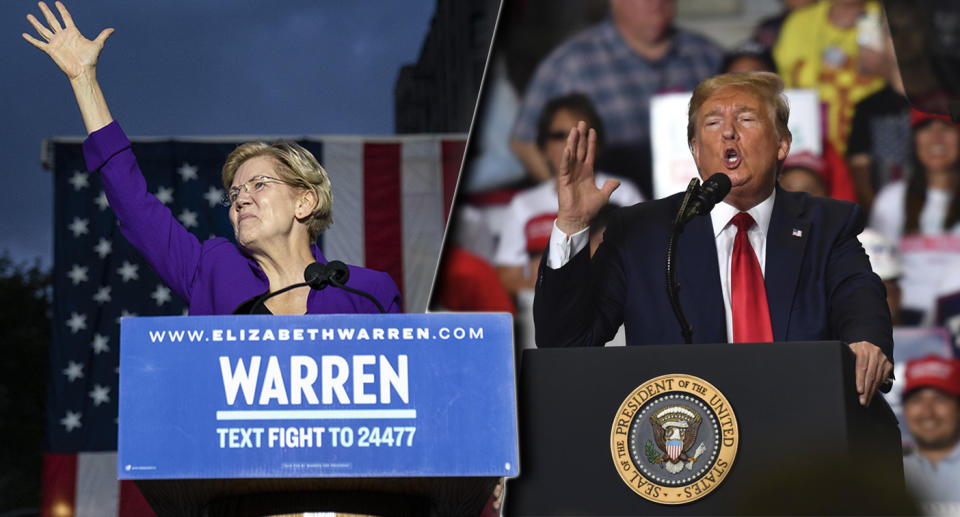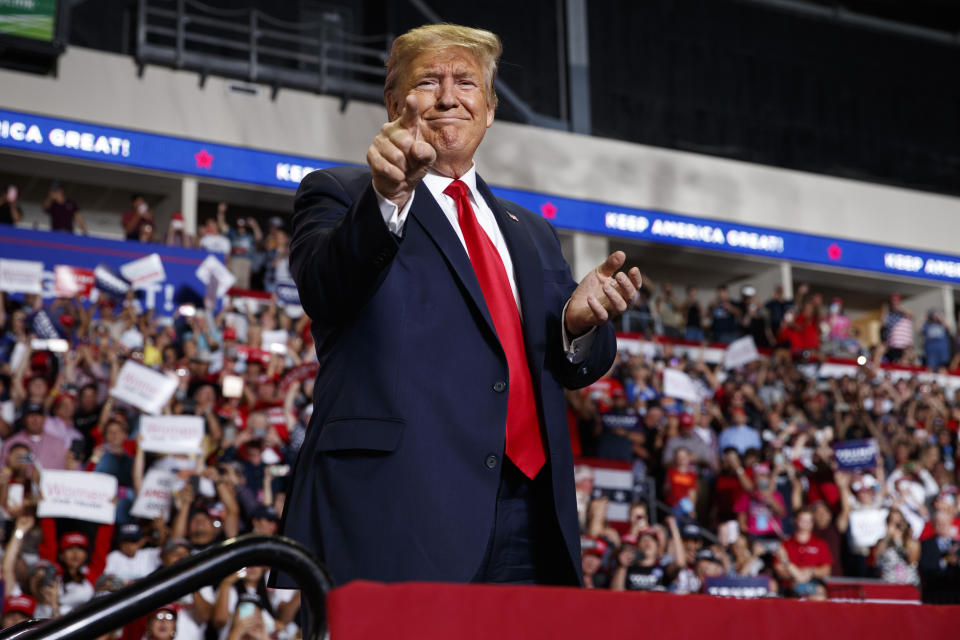2020 Vision Tuesday: What a race between Trump and Warren would look like

Welcome to 2020 Vision, the Yahoo News column covering the presidential race with one smart, fast takeaway every weekday and a deeper roundup every weekend. Reminder: There are 139 days until the Iowa caucuses and 413 days until the 2020 election.

For voters eager to see the endless Democratic primary come to a, you know, end, Monday night’s split-screen programming made it easy to imagine what at least one version of next year’s general election might look, feel and sound like: a pitched battle between two very different — but equally outspoken — brands of populism.
In one corner you had President Trump, the presumptive Republican nominee, doing his usual rally shtick before a crowd of 7,500 at the Santa Ana Star Center in Rio Rancho, N.M.

In the other corner you had Elizabeth Warren, the only Democratic candidate to show a slow but steady rise in the polls, railing against corruption before a crowd of more than 20,000 in lower Manhattan’s Washington Square Park, near where a deadly 1911 fire at the Triangle Shirtwaist Factory helped accelerate the American labor movement. The building devastated by the fire is now part of the New York University campus.
Newsletter: The Yodel
Trusted news and daily delights, right in your inbox
See for yourself — The Yodel is the go-to source for daily news, entertainment and feel-good stories.
Thematically, there was plenty of overlap between Trump and Warren. Both pitted the people against some powerful, shadowy oppressor. Both claimed they were on the side of the former, not the latter.
But what was most striking is how they played similar populist material in totally different keys.
For Trump, the oppressors were the so-called “Washington elite” — indistinguishable, in his book, from “radical left Democrats.”
“The left tries to threaten, bully, intimidate Americans into submission,” Trump said. “[They] want to demolish everything that we’ve gained. They want to raise your taxes, they want to bury you in regulation. They want to take away your health insurance — 180 million Americans. They want to erase American history, crush religious liberty, indoctrinate our students with left-wing ideology and … confiscate your guns and eliminate your God-given right to self-defense.”

For Warren, the oppressors were “giant corporations” — indistinguishable, in her book, from the lobbyists who serve them and the billionaires and ultramillionaires who profit from them, including Trump himself.
“Donald Trump is corruption in the flesh,” Warren said. “He is sworn to serve the people of the United States, but he serves only himself and his partners in corruption. He tries to divide us … because if we’re all fighting each other, no one will notice that he and his buddies are stealing more and more of our country’s wealth and destroying the future for everyone else.”
If Warren wins the Democratic nomination, this is how the general election will be fought: as a war between her brand of populism, which is wholly economic, and Trump’s brand of populism, which is almost entirely cultural.
And so Trump attacked the “fake news” media, and the “deep state,” and “phony polls,” and LED light bulbs, and anti-cow environmentalists and sanctuary cities — all on behalf of the “forgotten men and women” who voted for him in the “beautiful election” of 2016. (The ostensible point of his visit was to flip New Mexico, but his pitch didn’t amount to much more than a few token mentions of “Hispanics.” “We got a lot of Hispanics, we love our Hispanics, get out and vote,” Trump said.)
Warren, meanwhile, attacked “huge fossil fuel corporations,” and “the gun industry,” and “health insurance companies,” and “drug companies” and “a multibillion-dollar influence industry whose sole purpose is to undermine democracy,” all while detailing her many plans for “big, structural change” and casting her campaign as the natural successor to other populist movements led by women.

“Corruption in Washington has allowed the rich and powerful to tilt the rules and grow richer and more powerful,” she said. “But this small slice at the top hasn’t just scooped up a huge chunk of the wealth all of us have worked hard to produce — they’ve also gobbled up opportunity itself. For the rich and powerful, there are first, second, third and fourth chances to get ahead. But for a lot of Americans, and especially for people of color, there’s barely one — or, for some, no chance at all. We have the power to fix that.”
Ever since Warren stumbled out of the gate with her Native American DNA test, pundits and voters have questioned her “electability.” But an interesting thing has happened in recent months as she has put her populism up against Trump’s in a series of disciplined, on-message speeches and debate performances. In June, a CBS News/YouGov poll showed that only 39 percent of early primary state voters thought Warren could “probably” beat the president next November. Earlier in September, a full 55 percent said the same thing — a 16-point jump.
In other words, relentless economic populism seems to be working for Warren — in part because it has reassured skittish progressives that she won’t let Trump get in her head, and in part because, among Democrats, it may be starting to seem like the most effective antidote to the cultural populism that propelled the president into the White House.
On Monday, even Trump seemed to pick up on the shift.
“You know, the Pocahontas thing, I did that. … It was before its time,” he said. “Too early. … I was early with her. [But] oh, it’s coming back — don’t worry about that.”


Download the Yahoo News app to customize your experience.
Read more from Yahoo News:
